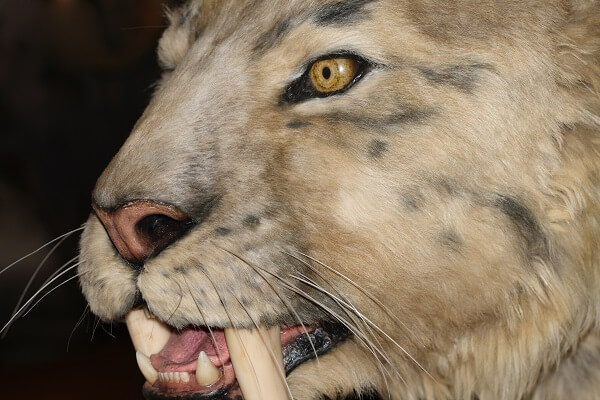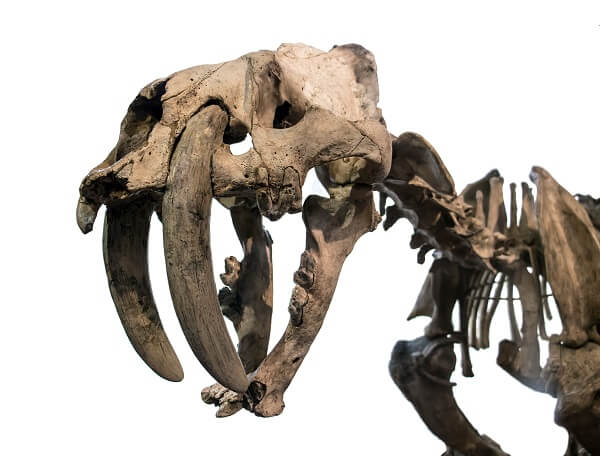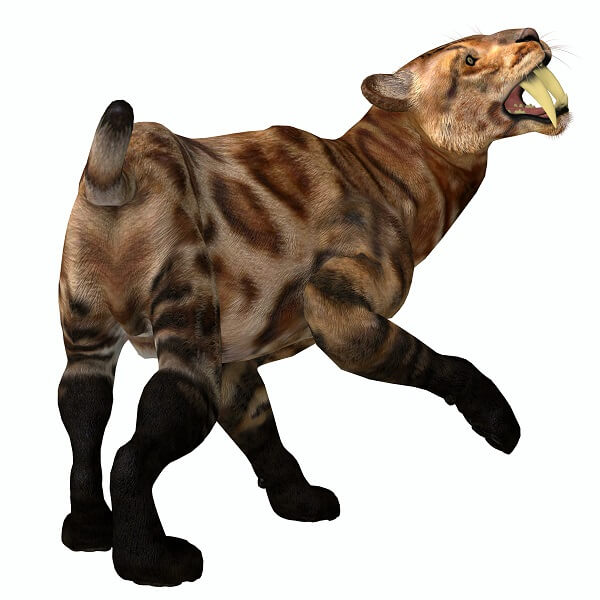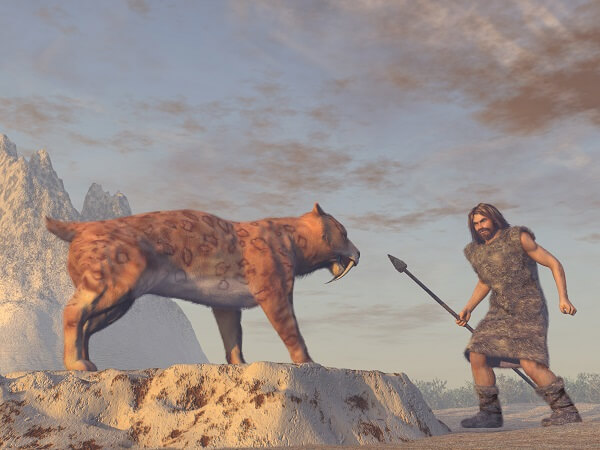
The saber tooth tiger is one of the most widely known species of saber toothed cats from the genus Smilodon. This extinct cat was named for the pair of elongated teeth in its upper jaw. The saber tooth tiger was found across North and South America during the Pleistocene Epoch. It went extinct approximately 10,000 years ago. Unlike its name suggests, these cats are not related to the modern-day tigers found in Asia. In fact, the saber tooth tiger got its name from its large canine teeth that could grow over 7 inches in length. Its teeth were narrow, curved, and had extremely sharped edges that enabled it to slice through soft tissue. They were quite fragile, though, and may have broken if they had hit bone instead of flesh. Scientists have uncovered a number of saber tooth tiger skeletons and fossils. From this, we know that saber tooth tigers were large cats that had short limbs. Scientists think that these cats would have been similar to a modern-day African lion (Panthera Leo) in both size and color, although it is not related to lions either. They were dominant predators that preyed upon large herbivores such as deer and bison. It is also thought they would have eaten the occasional small woolly mammoth. The large cats are likely to have bred in the spring, with the female giving birth to a maximum of three cubs. There is not a lot known about saber tooth tiger cubs, but researchers think that they were born blind like other cats. They had no natural predators. It is thought that they were hunted to extinction by humans. The saber tooth tiger is one of the most well-known prehistoric animals that was named for its enormous canines. Still, these weren’t the only biological adaptations that made the saber tooth tiger such a successful predator. Let’s take a close look. The saber tooth tiger had several adaptations that enabled it to have such large teeth. The cats had a wide gape that enabled it to open its mouth to 120 degrees. This is double that of today’s lions, who can open their mouths to 60 degrees. This wide gape was necessary to allow the cats to get the full use of their teeth, which could be up to 28 cm in length. The skull also had a modification that enabled it to accommodate the attachment of strong neck muscles, which helped it to bring its head down. This suggests that it hunted by stabbing and slashing at its prey with its teeth. The limbs of these cats were shorter and thicker than that of other felines. They also had powerful abductor muscles and denser bones. This would have helped the cats’ stability and given them more power when wrestling with their prey. These physical adaptations suggest that saber tooth tigers were ambush hunters that stalked their prey. The structure of their head (as mentioned above) and their teeth provide further evidence for this theory. Saber tooth tigers also had one other adaptation that supports the theory that they were ambush hunters. Unlike modern-day cats, such as lions and cheetahs, Saber tooth tigers had a bobtail. A long tail is used by big cats to provide stability and balance when they are chasing their prey. Without this long tail, it is more likely that these big cats would have hidden and waited for their prey. Once they had surprised their prey, they would have delivered a fatal bite using their impressive canines. Unlike modern cats – such as tigers and house cats – which are solitary hunters, the saber tooth tiger was a social animal. It is thought that they lived in packs and had a social structure much as lions do. Fossils found all over North America provide evidence for this theory. Smilodon fossils found in the La Brea tar pits show proof that some of the animals had experienced fractures, severe crushing, crippling arthritis, and other degenerative diseases. If these cats were solitary hunters, it is likely they would have died before these wounds healed. Many of the bones found showed extensive healing and regrowth. This suggests that the cats survived after their injuries and were most likely cared for by other cats. At the very least, the other cats enabled them to feed. The bones did, however, show some evidence of evidence from other saber tooth cats, suggested that fights sometimes broke out, most likely over females.
Kingdom
Animalia
Phylum
Chordata
Class
Mammalia
Order
Carnivora
Family
Felidae
Genus
Smilodon
Species
Smilodon populator
Niche
Carnivorous
Length
79 – 98 in (2 – 2.5m)
Weight
661 lbs ( 300 kg)
Lifespan
20 – 40 years
Social Structure
Social
Conservation Status
Extinct
Preferred Habitat
Forests and grasslands
Average Litter Size
3
Main Prey Species
deer, bison and small woolly mammoths
Main Threats
Humans
The Basics

Interesting Insights from the Saber Tooth Tiger!
Physical Adaptations – Head

Physical Adaptations – Limbs

Social Behaviour
